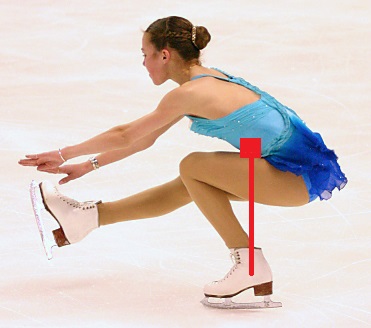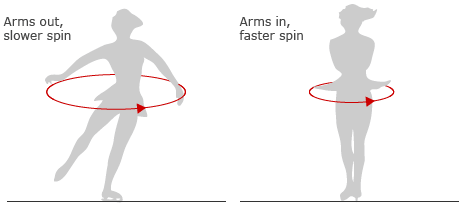
The
sport of figure skating
is well known for its graceful execution thanks to iconic
Olympic Figure Skaters like Michelle Kwan and Peggy Fleming, but
it’s easy for viewers to overlook the amount of strength, power
and perseverance it takes to be a successful figure skater. In
the pages following we will take a look at some of the physics
hiding behind these elegant athletes.

Center
of Mass is probably the single most important thing in
understanding how athletes such as figure skaters, gymnasts,
skiers, etc. are able to do the things that they do. Simply put,
center of mass is the mass weighted center of an object (or
person). On a human body, the center of mass is generally
located near the belly button or right above the hip area. The
location of a figure skaters center of mass during any type of
skating movement can greatly effect the stability of the skater.
The stability of an object will always be greater if the objects
center of mass is located over its base of support. This fact is
why beginning skaters or skiers are always told to bend their
knees and do their best to keep their feet (base of support)
located directly beneath them. Center of mass is something that
all figure skaters need to be aware of, especially when
executing advanced movements such as, triple axels or flying
camel spins.
A
projectile, such as a ball or figure skater, is an object that
moves in two dimensions (horizontal and vertical) along a
parabolic trajectory curve solely under the influence of
gravity. In figure skating, projectile motion can be most
readily seen when a skater performs a large jump where the
parabolic trajectory is most noticeable. Although not as clear
to point out, projectile motion can occur during small footwork
steps or in the entrance of a spin.


Angular Momentum, also known as rotational momentum, can be defined as the amount of rotation an object experiences. It is a vector quantity, meaning it has both a magnitude and a direction, and it depends on the objects moment of inertia and its angular velocity. Angular momentum is essentially the product of the objects moment of inertia and the objects angular velocity. In figure skating, the concept of angular momentum is extremely important in order to complete a successful jump or spin, without it there would be no spinning at all!
Just for fun section! (includes funny faces
of figure skaters...)